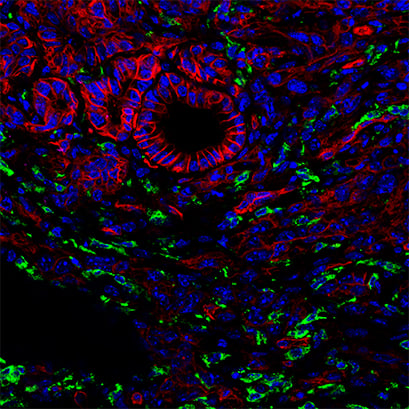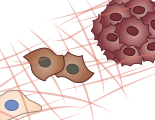Cancer and Oncology
Cancer: Definition, Facts, and Hallmarks
Cancer is a large, diverse group of diseases. It is defined by uncontrolled cell growth anywhere in the body, with the potential to spread ("metastasize") to other organs. In 2020, an estimated 19.3 million new cancer cases and almost 10.0 million cancer deaths occurred worldwide. The most commonly diagnosed cancer is breast cancer, followed by lung, colorectal, prostate, and stomach cancers. In many countries, cancer ranks among the most common causes of death, and the numbers are increasing anually (Sung et al., 2021). This illustrates the emerging need to develop novel therapies, which can only be realized by increasing the knowledge about the highly complex fundamentals of neoplastic diseases.
Tumors can develop almost everywhere in the human body and have many different manifestations. In spite of this diversity, some characteristics apply to all types of cancer, such as the uncontrolled proliferation of cells and their potential to metastasize to other parts of the body. Whereas cancer is relatively rare in children (with leukemia as predominant childhood cancer), increasing age is a clear risk factor for being affected. Further general risk factors are genetic predisposition and various environmental effects (e.g., smoking as one of the leading causes of lung cancer and ultraviolet light for skin cancer).

Confocal microscopy of tumor-associated macrophages (GFP, green) infiltrating the pancreatic tumor tissue (Tomato, red). Nuclei are stained with DAPI (blue). Tissue sample of an endogenous pancreatic cancer mouse model with a double-fluorescent reporter gene to target macrophages. Data by Stefanie Bärthel, Translatum, Technical University of Munich, Germany.
Some tumor types are very aggressive: pancreatic cancer (i.e., pancreatic ductal adenocarcinoma, PDAC), has a high metastasizing rate and only a few therapeutic options, resulting in 5-year-survival rates below 8% (Orth et al., 2019). Other types have a very positive overall outcome: basalioma (basal cell carcinoma, BCC), which is the most common type of skin cancer, only rarely metastasizes and, in most cases, can be completely excised by surgery (Rogers et al., 2015).
During the process of tumor development, cancer cells acquire defined biologic capabilities. They resist cell death, induce angiogenesis, sustain proliferative signaling, evade growth suppressors, activate invasion and metastasis, and enable replicative immortality—all these processes were published as the "Hallmarks of Cancer" back in 2000 by Hanahan and Weinberg. A decade later, these hallmarks were complemented by further hallmarks (avoiding immune destruction and deregulating cellular energetics), as well as the "enabling characteristics" (tumor-promoting inflammation as well as genome instability and mutation).
With their enormous work in basic and applied cancer research, thousands of scientists contribute every day to deciphering cancer mechanisms. ibidi helps these researchers develop therapeutics against this dismal disease with a variety of tailored solutions for cell-based assays and high-end microscopy.

ibidi Blog Article |
Want to know insights on cancer-related cell culture experiments? Raúl Peña (IMIM, Barcelona, Spain) communicates this topic in his article "The Patient in Focus: How to Use Cell Assays for the Discovery of New Cancer Therapies" in the ibidi Blog.
For a better life without cancer!
Sung, H., Ferlay, J., Siegel, R. L., Laversanne, M., Soerjomataram, I., Jemal, A., & Bray, F. (2021). Global Cancer Statistics 2020: GLOBOCAN Estimates of Incidence and Mortality Worldwide for 36 Cancers in 185 Countries. CA: A Cancer Journal for Clinicians. 10.3322/caac.21660
Read article
Orth, M., Metzger, P., Gerum, S., Mayerle, J., Schneider, G., Belka, C., Schnurr, M., & Lauber, K. (2019). Pancreatic ductal adenocarcinoma: biological hallmarks, current status, and future perspectives of combined modality treatment approaches. Radiation Oncology. 10.1186/S13014-019-1345-6
Read article
Rogers, H. W., Weinstock, M. A., Feldman, S. R., & Coldiron, B. M. (2015). Incidence Estimate of Nonmelanoma Skin Cancer (Keratinocyte Carcinomas) in the U.S. Population, 2012. JAMA Dermatology. 10.1001/JAMADERMATOL.2015.1187
Read article
Hanahan, D., & Weinberg, R. A. (2011). Hallmarks of cancer: The next generation. Cell. 10.1016/j.cell.2011.02.013
Read article
How ibidi Contributes to Cancer Research
ibidi develops solutions and products that facilitate a variety of cell culture assays covering the different aspects of cancer development and the metastatic cascade.
More than 16000 cancer-related publications using ibidi products show the outstanding contribution of ibidi to the large field of cancer research.
Various in vitro approaches, such as migration assays, chemotaxis assays, angiogenesis assays, or perfusion assays, will help you analyze the individual steps of cancer and metastasis. In addition, we offer detailed solutions for the complete workflow of your cell-based assay, from sample preparation to image analysis, to get you reproducible and valid results.
Learn more about ibidi solutions in your field of interest here:









